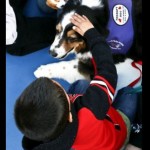 Americans’ affection for their animals continues to fuel a booming pet products industry. Owners are on track to spend $55.5 billion on their furry friends this year. Growing spending on pets has its roots in the 1950s and ’60s, when baby boomers became the first generation to routinely grow up with animals kept in the home, experts say. Today, boomers are filling their empty nests with companion animals. The Columbus Dispatch (Ohio)
Americans’ affection for their animals continues to fuel a booming pet products industry. Owners are on track to spend $55.5 billion on their furry friends this year. Growing spending on pets has its roots in the 1950s and ’60s, when baby boomers became the first generation to routinely grow up with animals kept in the home, experts say. Today, boomers are filling their empty nests with companion animals. The Columbus Dispatch (Ohio)
This year, Americans will spend an estimated $55.5 billion on their pets, a little more than the gross domestic product of Bulgaria.
And Americans probably will spend even more next year, just as they have every year for the past two decades.
Little wonder, then, that these are boom times in the pet industry. In one example, Petsmart reported it sold $1.9 million worth of goods and services in the fourth quarter alone.
“It’s an industry that continued to grow during the recession,” said retail analyst Chris Boring, principal at Boulevard Strategies. “In Ohio, the number of dog licenses issued is growing faster than the birth rate.”
The reason for such unstoppable growth can be traced to the baby-boom generation and its humanization of pets, Boring said.
“They grew up in the 1950s and ’60s, and one of the most-popular TV shows for families was Lassie,” Boring said. “Every little kid begged his folks to buy a dog.”
As a result, “the baby boom generation was the first generation, really, that commonly had household pets,” Boring said. “Prior to that, most domestic animals were kept outside. Cats were kept in barns or on porches, and dogs had dog houses out back.
“Now that baby boomers have become empty nesters, they’re adopting pets in record numbers. I think it’s to fill an emotional need when the last child leaves home.”
They’re not only adopting pets in record numbers, but spending more on each pet, said Dave Bolen, CEO of Pet Supplies Plus, which just opened two more stores locally — one in Grove City and one in Delaware — bringing its Columbus total to seven. The 280-store chain has been doing business locally for about 25 years.
“The people who shop our stores don’t own pets. The pets own them,” Bolen said. “It’s true. The pets run the household. If you go to our stores, you’ll note that all of the signage is the pet talking to you. Our marketing is the same thing, it’s all in the voice of the pet. The pet’s the boss.”
As might be expected, food is the highest annual expense for most pet owners, according to the American Pet Products Association. Owners on average spend $239 on food for dogs and $203 on food for cats. Overall, pet owners will spend a total of $21.3 billion on food this year.
But it’s not just quantity of food. Pet owners — or “parents,” as they’re known in the industry — are going after high quality in their food, too. “That’s a really big deal, organic food,” Bolen said. “It very much follows the trend in natural food in the human space.” In response, his company offers 33 brands of pet foods that don’t contain synthetic additives, artificial preservatives, fillers or animal byproducts.
Pet Supplies Plus is hardly alone in the move toward organic pet food.
In the Short North, “a particularly pet friendly area,” Boring said, Three Dog Bakery touts that its “all-natural dog food” is something that owners “can feel good about sharing with their furry family members.”
Pet People, another national chain which has its divisional headquarters in Columbus, also touts its “high quality, natural, wholesome, and nutritious pet foods and treats.”
The big spending doesn’t end with food. Pet owners are also spending more on human-style fashion gear, grooming and boarding. The American Pet Products Association expects pet owners to spend $5.5 billion on grooming and boarding services this year.
At the prompting of one franchise owner who noticed the rising demand for grooming, Pet Supplies Plus began offering a self-service dog wash, Bolen said. “Sometimes trying to give a larger dog a wash in the home is hard. It’s much easier to do in the dog wash.”
Among the offerings at Posh Pets Boutique in the Short North, for instance, are “the newest organic cotton crocheted toys” and “new winter styles to keep your favorite pet toasty!”
“They’re at a point where they can afford to spoil their pets — and they do,” Boring said. “People are cooking special meals for their dogs, and then there are some of these places where, you call it boarding, but it’s more like plush hotels. It’s almost like anything you can apply to humans can apply to dogs. And it is usually dogs. Cats don’t really care. I say that as a cat owner.”
The pampering even extends to psychological considerations. One product, Neuticles, “allows your pet to retain his natural look, self-esteem and aids in the trauma associated with altering.” Pet owners have bought more than half a million of the prosthetic testicular implants, which sell for about $1,000 a pair.
“I saw a cat stroller the other day for some ridiculous price,” Boring said. “My first question is, what cat would let you put it in a stroller?”










